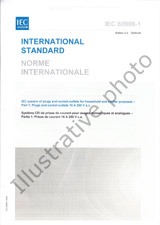We need your consent to use the individual data so that you can see information about your interests, among other things. Click "OK" to give your consent.

IEC 62552-2-ed.1.0
Household refrigerating appliances - Characteristics and test methods - Part 2: Performance requirements
STANDARD published on 13.2.2015
The information about the standard:
Designation standards: IEC 62552-2-ed.1.0
Publication date standards: 13.2.2015
SKU: NS-579881
The number of pages: 86
Approximate weight : 289 g (0.64 lbs)
Country: International technical standard
Category: Technical standards IEC
The category - similar standards:
Annotation of standard text IEC 62552-2-ed.1.0 :
IEC 62552-2:2015 specifies the essential characteristics of household refrigerating appliances cooled by internal natural convection or forced air circulation, and specifies test methods for checking the characteristics. This part of IEC 62552 describes the methods for the determination of performance requirements. Although there is some commonality in the set-ups for different tests (and so it may be an advantage to apply them all to one sample), these are separate tests to evaluate specific characteristics of the sample being tested. This part of IEC 62552 does not specify a procedure to generalise the results from sample test results to a prediction of the characteristics of the whole population from which that sample was selected. IEC 62552-1, IEC 62552-2 and IEC 62552-3 cancel and replace the first edition of IEC 62552 published in 2007. IEC 62552-1, IEC 62552-2 and IEC 62552-3 together constitute a technical revision and include the following significant technical changes with respect to IEC 62552:2007: - A cooling capacity test has been added in Part 2 (this part). - A pull-down test has been added in Part 2 (this part). - Performance tests have been added for wine storage appliances in Part 2 (this part). LIEC 62552-2:2015 specifie les caracteristiques essentielles des appareils de refrigeration a usage menager refroidis par convection naturelle interne ou par circulation dair force, et specifie les methodes dessai pour la verification des caracteristiques. La presente partie de lIEC 62552 decrit les methodes de determination des exigences de performances. Meme si les montages presentent certaines similitudes pour les differents essais (et quil peut donc saverer avantageux de les appliquer a un seul echantillon), il sagit dessais distincts permettant devaluer les caracteristiques specifiques de lechantillon en essai. La presente partie de lIEC 62552 ne specifie pas de procedure visant a generaliser les resultats dessai sur echantillon a une prediction des caracteristiques de lensemble de la population a partir de laquelle ces echantillons ont ete selectionnes. LIEC 62552-1, lIEC 62552-2 et lIEC 62552-3 annulent et remplacent la premiere edition de lIEC 62552 publiee en 2007. LIEC 62552-1, lIEC 62552-2 et lIEC 62552-3 constituent une revision technique et incluent les modifications techniques suivantes par rapport a lIEC 62552:2007: - Un essai de capacite de refroidissement a ete ajoute dans la Partie 2 (la presente partie). - Un essai de mise en regime a ete ajoute dans la Partie 2 (la presente partie). - Des essais de performance ont ete ajoutes pour les appareils de stockage du vin dans la Partie 2 (la presente partie).
These changes apply to this standard:
Amendment 1 - Household refrigerating appliances - Characteristics and test methods - Part 2: Performance requirements
(Amendement 1 - Appareils de refrigeration a usage menager - Caracteristiques et methodes d´essai - Partie 2: Exigences de performances)
Change published on 30.11.2020
Selected format:Show all technical information.
Amendment 2 - Household refrigerating appliances - Characteristics and test methods - Part 2: Performance requirements
Change published on 27.8.2025
Selected format:Show all technical information.
We recommend:
Updating of laws
Do you want to be sure about the validity of used regulations?
We offer you a solution so that you could use valid and updated legislative regulations.
Would you like to get more information? Look at this page.



 Cookies
Cookies
